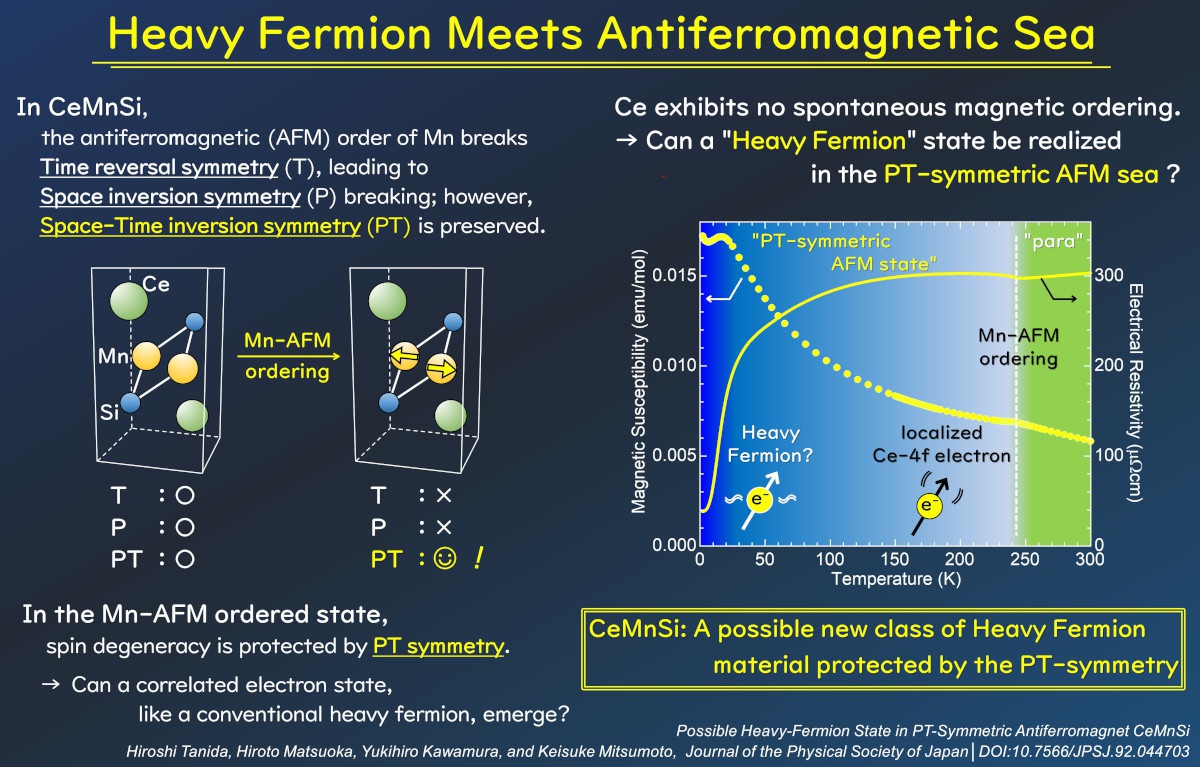Heavy Fermion Meets Antiferromagnetic Sea
© The Physical Society of Japan
This article is on
Possible Heavy-Fermion State in PT-Symmetric Antiferromagnet CeMnSi
(JPSJ Editors' Choice)
J. Phys. Soc. Jpn.
92,
044703
(2023)
.
CeMnSi exhibits heavy fermion behaviors in an antiferromagnetically ordered state of Mn.
The space-time inversion symmetry inherent in the ordered state is key for the unique electron state.

Symmetries are widespread in nature. For instance, planetary motion is related to the conservation of angular momentum owing to rotational symmetry. In general, symmetries have important implications for physics, and new concepts based on symmetries open up new frontiers of research.
Crystals are one of the research objects in condensed matter physics, and have innumerable atoms arranged periodically with symmetries, including rotation, mirror, and inversion. Space-inversion (P) symmetry is of importance for physical properties; however, it is not always present in crystals. Magnetic ordering, a familiar example of spontaneous symmetry breaking in electron systems, may break P-symmetry depending on the spatial arrangement of electron spins even if the symmetry is innately given. Magnetic ordering itself also breaks time-reversal (T) symmetry owing to the nature of electron spin, as in the Zeeman effect. We investigate how electrons behave in crystal, and thereby know which symmetries are broken.
CeMnSi is a tetragonal intermetallic compound with P-symmetry, and has two magnetic elements: Ce and Mn. The spin degrees of freedom of their unpaired electrons must be frozen at low temperatures in some way according to a thermodynamic requirement. As for Mn, the way is an antiferromagnetic (AFM) ordering with an antiparallel spin arrangement. Consequently, the innate P-symmetry is broken, while the space-time inversion (PT) symmetry, a combination of P and T symmetries, is preserved. Hence, CeMnSi is classified as a PT-symmetric antiferromagnet.
As for Ce, there is no spontaneous magnetic ordering. However, this is not so surprising for Ce-based intermetallics because they have another way for the freezing, the Kondo coupling with conduction electrons. In this case, unpaired Ce-4f electrons become nonmagnetic below a characteristic temperature, and a correlated electron state called the heavy fermion state is realized. The most salient feature of the heavy fermion state in CeMnSi is the presence of the Mn-AFM ordering; heavy fermion states normally appear in paramagnetic state. In other words, CeMnSi provides a place where heavy fermion meets an “AFM sea”. The spin degeneracy protected by the PT-symmetry inherent in the Mn-AFM ordering would be crucial for the unique heavy fermion state in CeMnSi beyond the usual heavy fermion picture. The microscopic mechanisms need to be clarified by theoretical and further experimental studies.
(written by H. Tanida on behalf of all authors.)
Possible Heavy-Fermion State in PT-Symmetric Antiferromagnet CeMnSi
(JPSJ Editors' Choice)
J. Phys. Soc. Jpn.
92,
044703
(2023)
.
Share this topic
Fields
Related Articles
-
Higher-Order Topological Phases in Magnetic Materials with Breathing Pyrochlore Structures
Electronic structure and electrical properties of surfaces and nanostructures
Magnetic properties in condensed matter
Mathematical methods, classical and quantum physics, relativity, gravitation, numerical simulation, computational modeling
2025-4-7
A simple example of a higher-order topological phase, in which the symmetry decreases step-by-step from the bulk to the corner, is realized in a magnetic system with a pyrochlore structure and is characterized by a series of quantized Berry phases defined for the bulk, surface, and edge.
-
Existence of Chiral Soliton Lattices (CSLs) in Chiral Helimagnet Yb(Ni1-xCux)3Al9
Magnetic properties in condensed matter
2025-4-1
Our study examines the magnetic structure of the monoaxial chiral helimagnet Yb(Ni1-xCux)3Al9, providing first direct evidence of the formation of chiral soliton lattice state.
-
Understanding Pressure-Induced Superconductivity in CrAs and MnP
Magnetic properties in condensed matter
2025-3-10
This study reviews existing research on the pressure-induced variation of magnetic properties of transition metal mono-pnictides like CrAS, MnP, and others, aiming to understand the unconventional superconductivity observed in CrAs and MnP.
-
Symmetry and AI: Building the Future of Physics Simulations
Magnetic properties in condensed matter
Measurement, instrumentation, and techniques
2025-2-18
Generative artificial intelligence (AI) has gained considerable attention in scientific fields. By embedding physical symmetry into AI before training, we created a faster and lighter model. Scaling improves the accuracy and unlocks the potential of physics research and applications.
-
Triangular Lattice Magnet GdGa2: Spin Cycloids and Skyrmions
Cross-disciplinary physics and related areas of science and technology
Electronic transport in condensed matter
Magnetic properties in condensed matter
2025-2-3
Careful measurements were conducted on the hexagonal magnet GdGa2 to reveal the experimental signatures of ultrasmall spin cycloids and of a potential Néel-type skyrmion lattice phase induced by a magnetic field.




